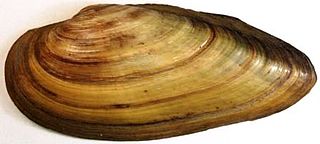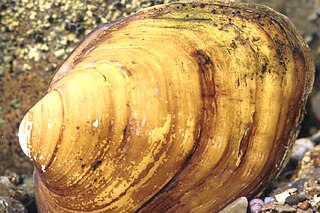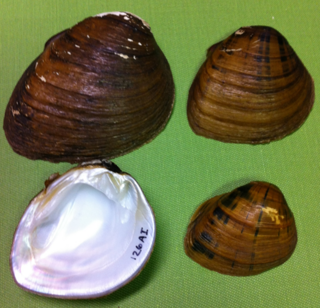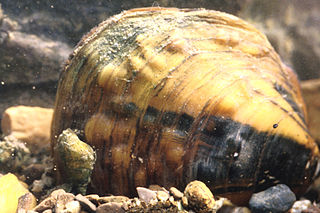
The Unionidae are a family of freshwater mussels, the largest in the order Unionida, the bivalve molluscs sometimes known as river mussels, or simply as unionids.

Unio is a genus of medium-sized freshwater mussels, aquatic bivalve mollusks in the family Unionidae, the river mussels. They are found throughout Europe, Africa, and the Middle East, with some species introduced to East Asia. Fossil species are also known from the Jurassic of North America.

Elliptio is a genus of medium- to large-sized freshwater mussels, aquatic bivalve mollusks in the family Unionidae, commonly known as the unionids, freshwater mussels or naiads.

Epioblasma is a genus of freshwater mussels, aquatic bivalve mollusks in the family Unionidae, the river mussels. Most of the species in this genus have been lost in modern times, and the entire genus is threatened with the possibility of extinction.

Epioblasma flexuosa, the arcuate pearly mussel or leafshell, was a species of freshwater mussel, an aquatic bivalve mollusk in the family Unionidae, the river mussels. This species was endemic to the United States, where it was found in the major drainages of the Ohio River, including the Cumberland, Tennessee, and Wabash Rivers. Its natural habitat was flowing water.

Epioblasma stewardsonii, the Cumberland leafshell or Steward's pearly mussel, is an extinct species of freshwater mussel in the family Unionidae.

Lampsilis is a genus of freshwater mussels, aquatic bivalve mollusks in the family Unionidae, the river mussels. There are over 100 species in the genus.

Sagittunio nasutus, the eastern pondmussel, is a species of freshwater mussel in the family Unionidae, the river mussels.

Plethobasus is a genus of freshwater mussels, aquatic bivalve mollusks in the family Unionidae, the river mussels.

Potamilus is a genus of freshwater mussels, aquatic bivalve mollusks in the family Unionidae, the river mussels.

Ptychobranchus is a genus of freshwater mussels in the family Unionidae.
Freshwater bivalves are one kind of freshwater mollusc, along with freshwater snails. They are bivalves which live in freshwater, as opposed to saltwater, the main habitat type for bivalves.

Charles Torrey Simpson was an American botanist, malacologist, and conservationist. He retired to Florida where he became known for conservation.

Epioblasma triquetra, common name the snuffbox mussel, is a species of freshwater mussel, a mollusk in the family Unionidae. It is native to eastern North America, where it is a listed as an endangered species in both Canada and the United States.

Pleuronaia dolabelloides, the slab-sided naiad, slab-sided pearly mussel, or slabside pearlymussel, is a species of freshwater mussel, an aquatic bivalve mollusk in the family Unionidae, the river mussels. This species was formerly classified under the genus Lexingtonia.
Pleuronaia barnesiana is a species of bivalve in the family Unionidae, common name Tennessee Pigtoe. It is endemic to the United States.

Cyclonaias pustulosa is a species of freshwater mussels, aquatic bivalve mollusks in the family Unionidae, the river mussels. This species is native to North America, where it is a widespread and common.

Sagittunio is a genus of freshwater mussels, aquatic bivalve mollusks in the family Unionidae.

Arcidens is a genus of freshwater mussels, aquatic bivalve molluscs in the family Unionidae, the river mussels.

Ambleminae is a subfamily of freshwater mussel in the family Unionidae. They are found throughout much of eastern North America south to Central America, although fossils are also known from Siberia. They are the most speciose radiation of the Unionidae, with more than 300 species.
















